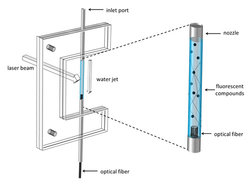 A naked jet of water that doubles as both the sample and the collection equipment, providing a simple, cheap, and portable new tool to analyze liquids. This is what a group of researchers of Irea, composed of Gianluca Persichetti and Genni Testa and led by Romeo Bernini, have designed and realized.
A naked jet of water that doubles as both the sample and the collection equipment, providing a simple, cheap, and portable new tool to analyze liquids. This is what a group of researchers of Irea, composed of Gianluca Persichetti and Genni Testa and led by Romeo Bernini, have designed and realized.
This is an optofluidic sensor that forgoes the channels in favor of a narrow stream of water unconfined by tubes or pipes. Typical microfluidic detectors for testing water are built to make use of the fluorescent property of pollutants and rely on narrow channels to hold and control the water samples with their fluorescing organic compounds. One of the major limitations of such devices is determined by the fact that laser light that illuminates bacteria and chemicals in the water also shines on the channel walls, where it scatters and obscures the distinction between the fluorescing contaminants and their background. The reliability of measurements made using these instruments is therefore weakened. Thanks to the new technique developed by researchers at IREA, water sample is pumped through a nozzle at 1.4 meters per second, producing a narrow stream that is less than a millimeter in diameter. When it is shined by UV laser, the fluorescent light produced by the pollutants and bacteria bounces around and is trapped inside the jet.
The researchers tested their device with varying amounts of some of the main pollutants of ground water which are hazardous and carcinogenic, finding that the device was extremely sensitive. It could detect pollutant levels even lower than those allowed by the Environmental Protection Agency (EPA). The instrument could also sense Bacillus subtillus, a harmless bacterium similar to the one that causes anthrax.
The device was developed in the framework of the research project ACQUASENSE. It does not require any pretreatment of the sample to be analyzed and can be easily plugged in normal water pipes. The extreme cheapness and compactness of the device make it suitable for its use in early warning systems for water quality monitoring.
The interest aroused by the research result is proved from having been selected for the news of the Optical Society of America (OSA).


